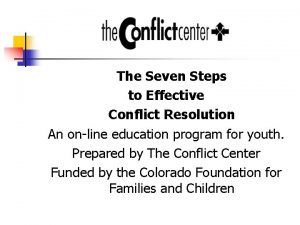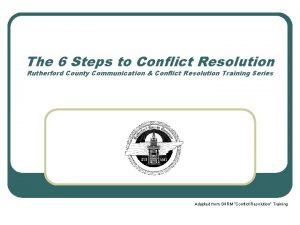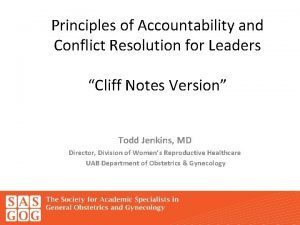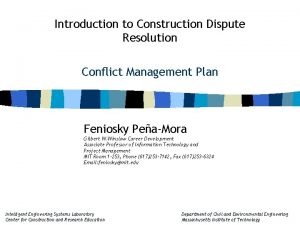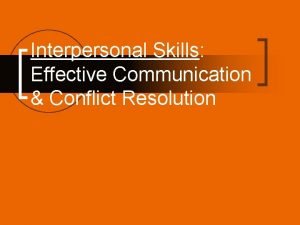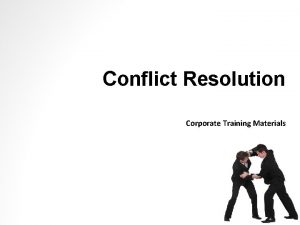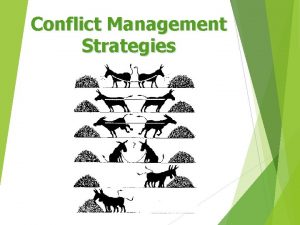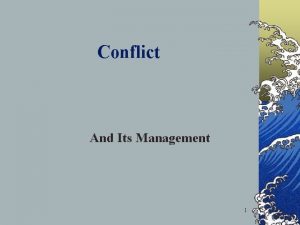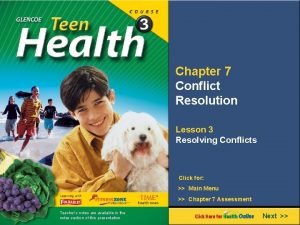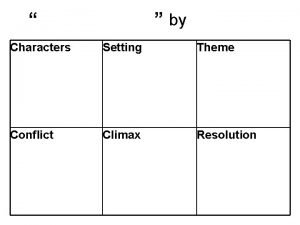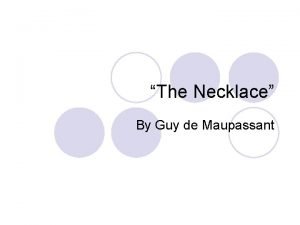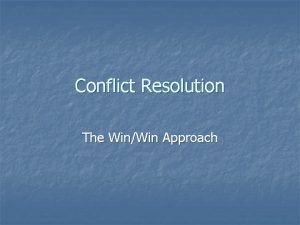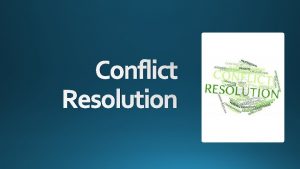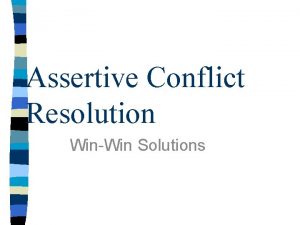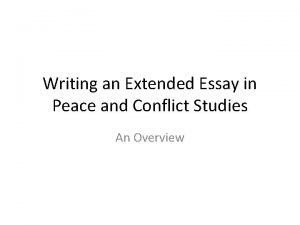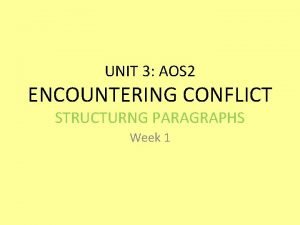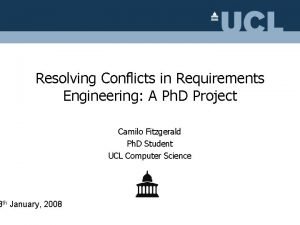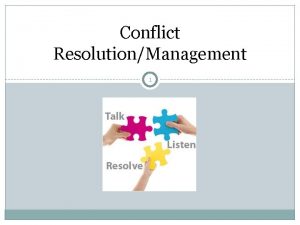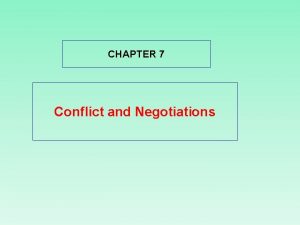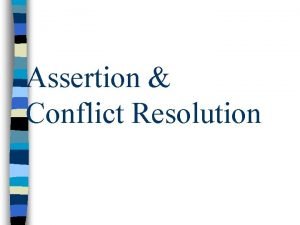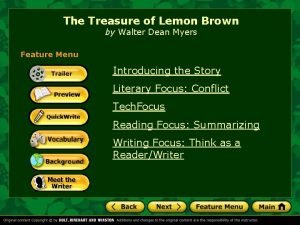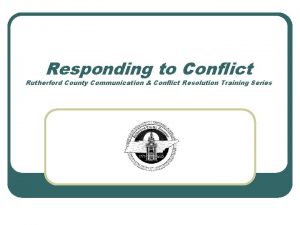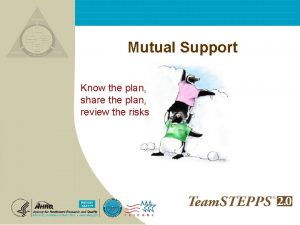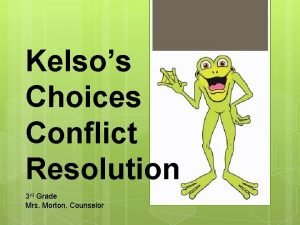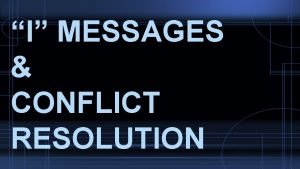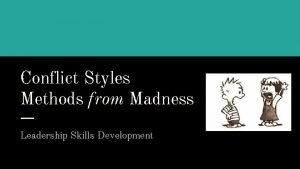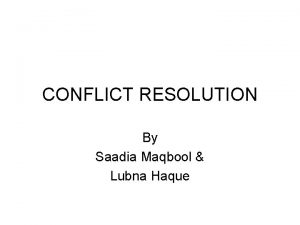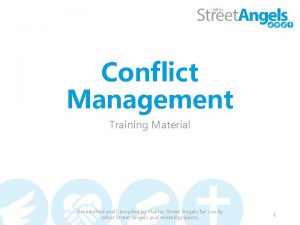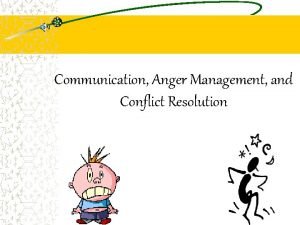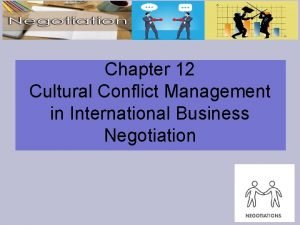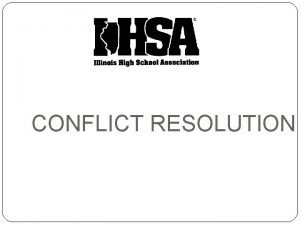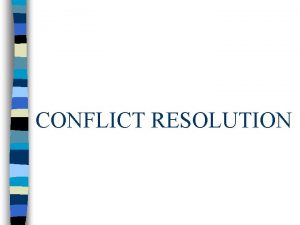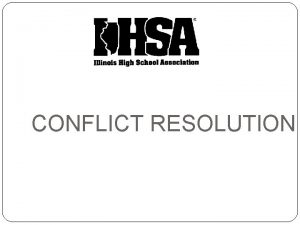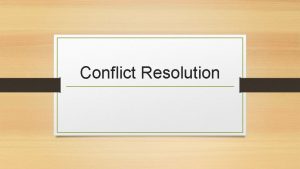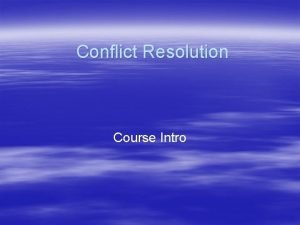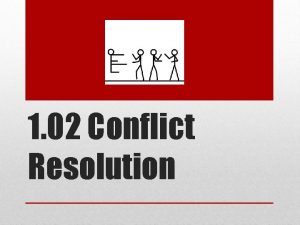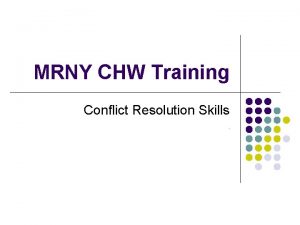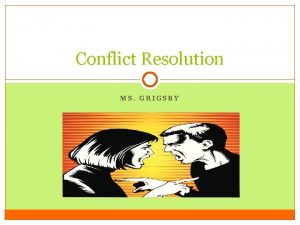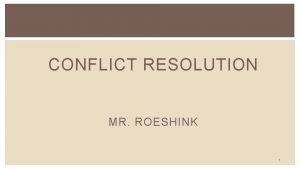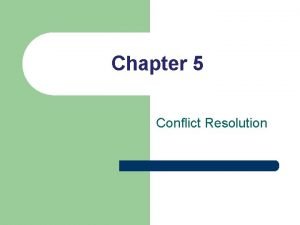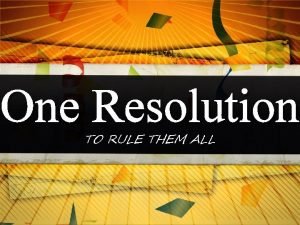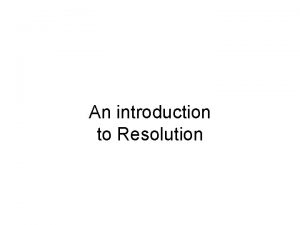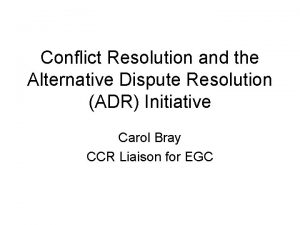Conflict Resolution Expectation Write one expectation on a










































- Slides: 42

Conflict Resolution

Expectation Write one expectation on a card • for this session only • be clear • be short (key words)

Objectives Ø reduce or eliminate unnecessary conflict Ø recognize that we can’t eliminate all conflict Ø handle disagreements so they do not become ugly ongoing conflict Ø share our experiences Ø have fun

Conflict A definition of “conflict” Ø “the result of parties disagreeing about the distribution of material or symbolic resources and acting on the basis of these perceived incompatibilities. ” Ø “is a state of discord caused by the actual or perceived opposition of needs, values and interests”

Conflict Ø is an ambiguous concept Ø takes on different meanings for different groups in different contexts Ø understood as a negative phenomenon HOWEVER

Conflict Ø more positive approach to understanding conflict has been adopted Ø indicative of change within society that enables the “peaceful & constructive management of differences”

Key Points Conflict in the workplace. . . Ø is inevitable & occurs because people care about what they are doing Ø needs to be looked at as an opportunity Ø can be productive or nonproductive – can be good or ugly Ø depends on how the disagreements are handled and if they are necessary to getting things done

Conflict occurs. . . when two or more parties Ø believe that their interests are incompatible Ø express hostile attitudes Ø take action that damages other parties’ ability to pursue their interests

In order to prevent destructive conflict and to deal with it effectively We need to understand something about what conflict is about

Ugly Conflict Ø occurs when conflict is unnecessary or becomes a personal confrontation Ø bad feelings generated & “defeat” each other rather than solving the issue Ø creates negative emotions Ø wastes time – being angry, defeating, lobbying for support Ø is disruptive for the team, causing lack of trust & discomfort

Ugly Conflict: How to Recognize it Ø runs for a long time & across many issues Ø people give up & try to score points rather than solve Ø focus on personal issues (styles, ways of talking & personal qualities) Ø people often labelled Ø look to a higher authority to “fix” problem using POWER

Good Organisational Conflict Ø allows organisation & people to grow Ø helps people examine what they take for granted & ineffective old ways of doing things Ø stimulates creativity & problem solving

To Benefit from Conflict Ø need to separate the personal, emotional aspects from the problem-solving parts (when overly invested in positions, tend to make enemies as conflicts become more personalized) Ø need skills & understanding to interact in conflict situations Ø need to understand how to “fight fair” & “stay focused on problem-solving”

People tend to resist communication, argue or perceive conflict when the other person. . . Group Work Ø at your tables Ø discuss for 5 minutes Ø choose 3 and write on card

People tend to resist communication, argue or perceive conflict when the other person. . . Ø provides unsolicited advice Ø tries to create guilt Ø offers false sympathy or lacks in understanding Ø pressures a person to change Ø appears to want to blame rather than fix Ø wants to “win” Ø uses excessive dramatic language Ø uses “hot words”, that have a heavy emotional connotation

Conflict Styles Survey Which style do you use?

Activity

Activity 1. spend 3 min to think of a time that you had a positive outcome to a conflict 2. stand up and find a partner - tell your stories 5 min 3. find another partner and tell the story you just heard (not yours) 4. repeat and tell the new story you heard 5. Repeat once more

5 Conflict Styles

Accommodating ü unassertive & co-operative ü neglects own concerns to satisfy others ü element of self-sacrifice (own goals are of little importance ü want to be accepted and liked by others ü think conflict should be avoided in favour of harmony ü may obey another person when would prefer not to

Competing ü is assertive & uncooperative ü win/lose and be winner ü power-oriented: forces one to accept their solution ü goals are more important than relationship ü do not care if others like/accept them ü win by attacking, overpowering, overwhelming & intimidating others ü might mean: standing up for own rights; defending a position you believe is correct or trying to win

Collaborating ü is both assertive & co-operative ü value own goals & relationships ü view conflict as problems to be solved ü seek solution to achieve goals for both ü can improve relationships by reducing tension ü attempt to work with other to find solution to satisfy both

Avoiding ü is unassertive & uncooperative ü does not pursue his/her own concerns or the others ü does not address conflict: easier to withdraw (physically & psychologically) than to face it ü may side-step the issue, postpone it for later or withdraw ü believe it is hopeless to resolve conflict & feels helpless

Compromising ü is intermediate in both assertive & co-operativeness ü seek solution where both sides gain something ü falls on middle ground between competing & accommodating - gives up more than competing but less than accommodating ü willing to sacrifice part of their goals & relationships to find common ground ü addresses issue more directly than avoiding ü might mean splitting the difference, exchanging concessions, or seeking a quick middle-ground position

High Importance G O A L S collaborating competing compromising avoiding accommodating RELATIONSHIPS Low Importance High Importance

Tools for Managing & Resolving Conflict At your tables discuss and list on cards 4 ground rules for effective conflict resolution One card per rule

Ways to work through conflict resolution… Ø Executive decision Ø Tolerate difference Ø Problem solve Ø Mediate & Arbitrate Ø Compromise Ø Listen & clarify Ø Negotiate Ø Accommodate Ø Avoid

Emotional Intelligence Using your head to manage conflict

Emotional Intelligence “ We are being judged by a new yardstick: not just how smart we are, or by our training and expertise, but also how well we handle ourselves and each other. ” Daniel Goleman, Working with Emotional Intelligence, 1998

Emotional Intelligence “ is the capacity to get optimal results from your relationships with yourself and others. ”

Emotional Intelligence 5 Domains 1. Self- awareness 2. Managing emotions 3. Motivating oneself 4. Empathy 5. Handling relationships

Emotional Intelligence: Research on Empathy To gain bargaining power by understanding the person on the other side of the table

Emotional Intelligence: Research on Empathy 2 Approaches Perspective-taking Empathy is the cognitive power is the power to to consider the world connect with them from someone else’s emotionally viewpoint

Emotional Intelligence: Research on Empathy It pays to get inside your opponents’ heads rather than their hearts

Using Positive Language

Language Negative Positive • Tells what can’t be done • Tells what can be done • Subtle tone of blame • Suggests alternatives & choices • Words that tell what you • Sounds helpful & cannot do: can’t, won’t, encouraging unable to • Stresses positive actions • Does not stress positive & consequences actions

Using Negative Language Identify and eliminate common negative phrasing Expressions that suggest carelessness: • You neglected to specify. . . • You failed to include. . . • You overlooked enclosing. . .

Using Negative Language Phrases that suggest the person is lying: • You claim that. . . • You say that. . . • You state that. . .

Using Negative Language Demanding phrases that imply coercion/pressure: • • • You should. . . You ought to. . . You must. . . We must ask you to. . . We must insist. . .

Using Negative Language Expressions that imply recipient is not too bright: • We cannot see how you. . . • We fail to understand. . . • We are at a loss to know. . .

Using Negative Language Phrases that might be interpreted as sarcastic or patronizing: • No doubt. . . • You understand of course. . . • Please respond soon. . .

Using Positive Language 1. If you can send us (…), we can complete the process for you. 2. Might we suggest that you (…) 3. One option open to you is (…) 4. We can help you to (…) if you can send us (…)
 What is conflict and conflict resolution?
What is conflict and conflict resolution? High resolution low resolution
High resolution low resolution Cudsa communication model stand for
Cudsa communication model stand for Expected behavior in work immersion
Expected behavior in work immersion Conflict resolution definition
Conflict resolution definition Six steps of conflict resolution
Six steps of conflict resolution Resident customer service
Resident customer service Accountability in conflict resolution
Accountability in conflict resolution Conflict resolution outline
Conflict resolution outline Conflict resolution is a(n) communication skill
Conflict resolution is a(n) communication skill Conflict resolution training materials
Conflict resolution training materials Thomas-kilmann conflict mode exercise
Thomas-kilmann conflict mode exercise Scope of conflict resolution
Scope of conflict resolution Steps in the mediation process
Steps in the mediation process Center for african peace and conflict resolution
Center for african peace and conflict resolution What conflict is introduced in this excerpt? justin lebo
What conflict is introduced in this excerpt? justin lebo Setting of the necklace story
Setting of the necklace story Staben conflict resolution
Staben conflict resolution Win-win conflict resolution
Win-win conflict resolution Watch mastering conflict management and resolution at work
Watch mastering conflict management and resolution at work Assertive conflict resolution
Assertive conflict resolution Peace and conflict essay
Peace and conflict essay Conflict resolution paragraphs
Conflict resolution paragraphs The alchemist climax
The alchemist climax Conflict resolution in software engineering
Conflict resolution in software engineering Watch mastering conflict management and resolution at work
Watch mastering conflict management and resolution at work Superordinate goals conflict resolution technique
Superordinate goals conflict resolution technique Passive conflict resolution
Passive conflict resolution Internal conflict in the treasure of lemon brown
Internal conflict in the treasure of lemon brown Six steps to conflict resolution
Six steps to conflict resolution Desc conflict resolution
Desc conflict resolution Mastering conflict management and resolution at work
Mastering conflict management and resolution at work Staben conflict resolution
Staben conflict resolution Kelso conflict resolution
Kelso conflict resolution Conflict resolution i messages
Conflict resolution i messages Data fusion tutorial
Data fusion tutorial Thomas-kilmann model
Thomas-kilmann model Conflict objectives
Conflict objectives Lubna haque
Lubna haque What does palms stand for in conflict resolution
What does palms stand for in conflict resolution Conflict transformation
Conflict transformation Conflict resolution in international business
Conflict resolution in international business Objectives about work immersion
Objectives about work immersion




